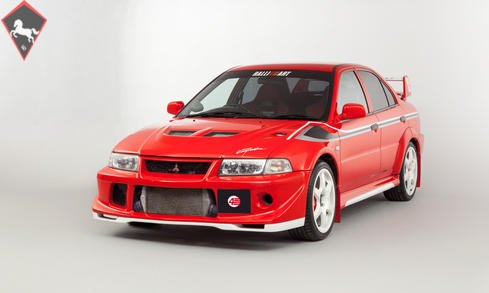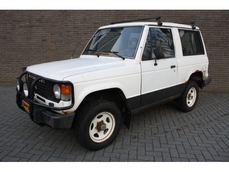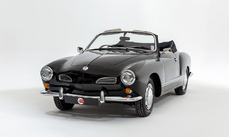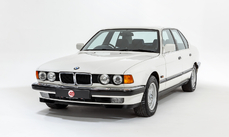Mitsubishi Other VI Tommi Makinen 2000
Allgemeine Beschreibung :
Model History
The Lancer Evolution was a high-performance sports car based on the standard Mitsubishi Lancer. There have been ten official versions to date, and the designation of each model is most commonly a Roman numeral. All use two-litre, turbocharged engines and all-wheel drive systems.
The Evolution was originally intended only for Japanese markets, but demand on the "grey import" market led the Evolution series to be offered through Ralliart dealer networks in the United Kingdom and in various European markets from around 1998. Japanese-spec cars were limited by a gentlemen's agreement to advertise no more than 276hp, a mark already reached by Evolution IV. Therefore, each subsequent version has unofficially evolved above the advertised power figures, with the Japanese-spec Evolution IX reaching an alleged output of around 317hp.
The Evo VI was produced from January 1999 until March 2001. The improvements over its predecessor mainly focused on cooling and engine durability. It received a larger intercooler, larger oil cooler, and new pistons. The Evolution VI received new bodywork yet again, with the most easily noticeable change being within the front bumper where the huge fog lights were reduced in size and moved to the corners for better airflow.
Great rally success was achieved in the WRC Rallies from 1996-1999 thanks to the legendry Finn Tommi Makinen for clinching the drivers titles in this period and help from team mate Richard Burns for clinching the constructors championship for the first, and thus far only time in 1998.
In 1999 the Tommi Makinen Edition was released. It featured a different front bumper, red and black Recaro seats embossed with the Tommi Makinen logo, 17-inch white Enkei wheels, a red-stitched leather Momo steering wheel and shift knob, a titanium turbine that spooled up more quickly, front upper strut brace, lowered ride height (with tarmac stages in mind), and a quicker steering ratio, among other things. The car is sometimes referred to as an Evolution 6.5, or TME for short.
The Tommi Makinen Edition was only available in Scotia White, Satellite Silver, Pyrenees Black, Canal Blue, and Passion Red (the only colour scheme available with the Works stripes and decals kit). Out of all the colours, the red is considered to be most collectable; certainly the used car market favours it as values are seen to be increasing year on year. In total there were 2,021 GSR and just 678 RS lightweight variants. It is believed that only 212 cars were produced in red with the Special Colour Pack.
Equipment
Passion Red paintwork with Special Colour Pack (SCP), TME embroidered Recaro front seats, 18-inch Compomotive alloy wheels in white, Front and side airdams accented in white, Twin-wing rear spoiler with high-mount stop lamp, Specially tuned suspension, Brembo brakes, Electric-folding door mirrors, Digital climate control AC, Electric windows, Power steering, Momo leather steering wheel with red stitching, Gear shift gaiter with red stitching, Front airbags, Remote central locking, Ralliart sunshade decal, Marlboro spoiler decals, Front and rear mudflaps, MLR carpet mats, Pioneer head unit, A-pillar boost gauge, Ralliart hard pipe kit, Carbon fibre plug cover, Spare key, Alarm.
Exterior
The gleaming Passion Red paintwork looks superb alongside the factory-correct works stripes and additional white accents to the lower body. Visually similar to the Championship winning cars made famous by rally legend Tommi Makinen, it comes as no surprise that Special Colour Pack TMEs like this one have fast become the most sought after of all. The paintwork appears in great condition all round and boasts a deep, uniform shine following a full machine polish. Aside from the usual light dusting of stone chips to the bumper, headlights, and leading edge of the bonnet there are relatively few blemishes to report. There is no corrosion to the bodywork, with all trim, plastics, and decals remaining in fine fettle throughout.
Additional photos, videos, and inspection report provided on request. FREE DELIVERY available within 150 miles - please call us for a discounted rate if you live further away.
Interior
The specially-embroidered TME Recaro seats present in fantastic original condition; the velour bolsters are usually the first areas to wear and fade but here they remain in excellent order with no rips or damage to report. Commonly worn items such as the dash and centre console are free from any significant marking, and the original Momo steering wheel still remains in great shape. A discreetly mounted A-pillar boost gauge provides the driver with additional feedback while the accompanying turbo timer executes a strict cool-down procedure after every drive.
ENGINE & TRANSMISSION
The turbocharged 2-litre rockets the Evo from 0-60 mph in little over 4 seconds. The five-speed manual gearbox still feels tight, and the all-wheel-drive system provides enough confidence to power though corners at speed. Despite its high-performance credentials, the Evo VI still drives with typical Japanese-car ease; operating smoothly at low speeds before launching into ferocious acceleration at anything above 4000 rpm.
The engine bay of this example is in good order with no signs of damage or poor repair. The car has been routinely maintained at close mileage intervals in recent years; the last service was carried out in September 2019 at the current mileage of 45k.
WHEELS, TYRES & BRAKES
The Evo sits on striking six-spoke Compomotive alloys, all in perfect unmarked condition and shod in a brand new set of Goodyear tyres. Stopping power comes from the factory-spec Brembo calipers front and rear, which effortlessly bring the car to a halt quickly and in a straight line.
History File
This rare Special Colour Pack Tommi Makinen was first registered in March 2000. It was imported from Japan into Ireland back in 2005 and has remained with the same keeper since 2008. The current owner has had the car regularly serviced under his ownership (a total of 9 times) despite covering little over 6k miles in the last 11 years. The last service has only recently been carried out and all four tyres have just been replaced.
http://www.4starclassics.com/for-sale/mitsubishi-evo-vi-tommi-makinen-for-sale/
2000 Mitsubishi Other VI Tommi Makinen is listed verkauft on ClassicDigest in Kingsley by 4 Star Classics for £27995.
Fakten der Auto
Karosserietyp : Auto Marke : Mitsubishi Modell : Other Ausführung : VI Tommi Makinen Hubraum : 2.0 Modelljahr : 2000 Karosstyp : Pick up Lage : Hampshire
Verkauft
Angaben Zum Verkäufer
Verkauft
People who viewed this Mitsubishi Other also viewed similar Mitsubishi listed at ClassicDigest
Other cars listed for sale by this dealer
über Mitsubishi
Mitsubishi: Eine Reise durch die Geschichte (bis in die 1980er Jahre)1. Frühe Anfänge:
Gründung: Mitsubishis Wurzeln reichen zurück zur Gründung einer Schifffahrtsfirma durch Yataro Iwasaki im Jahr 1870.
Diversifizierung: Das Unternehmen expandierte in den Bergbau, den Schiffbau und andere Branchen, was die Grundlage für die Mitsubishi Group bildete.
2. Erste Automobilunternehmungen:
Erste Automobilproduktion: Mitsubishi wagte sich im frühen 20. Jahrhundert in die Automobilproduktion.
Modell-A: Im Jahr 1917 führte Mitsubishi sein erstes Serienfahrzeug, das Modell-A, ein, Japans erstes Serienautomobil.
3. Nachkriegsära:
Umstrukturierung: Nach dem Zweiten Weltkrieg stand Mitsubishi vor Herausforderungen, durchlief jedoch eine Umstrukturierung und nahm die Automobilproduktion wieder auf.
Produktion von Jeeps: Anfangs konzentrierte sich Mitsubishi auf die Produktion von Jeeps und trug erheblich zur Wiederbelebung der japanischen Automobilindustrie bei.
4. Meilenstein-Modelle:
Mitsubishi 500: 1960 eingeführt, war der Mitsubishi 500 ein Kompaktfahrzeug, das dazu beitrug, kleinere Fahrzeuge in Japan populär zu machen.
Mitsubishi Colt 600: 1962 herausgebracht, war der Colt 600 ein Kleinwagen, der dazu beitrug, Mitsubishis Präsenz auf dem Automobilmarkt zu stärken.
5. Globale Expansion und die 1970er Jahre:
Partnerschaften: Mitsubishi schloss Partnerschaften mit internationalen Automobilherstellern und erweiterte damit seinen Einfluss über Japan hinaus.
Galant und Lancer: Modelle wie der Galant und der Lancer gewannen in den 1970er Jahren an Popularität und zeigten Mitsubishis Engagement für Innovation und Leistung.
6. Technologische Fortschritte:
Mitsubishi Astron-Motor: In den 1970er Jahren eingeführt, wurde der Astron-Motor zum Markenzeichen von Mitsubishi-Fahrzeugen und war bekannt für seine Langlebigkeit und Effizienz.
7. Höhepunkt der 1980er Jahre:
Mitsubishi Pajero: Anfang der 1980er Jahre eingeführt, markierte der Pajero (Montero in einigen Märkten) Mitsubishis Einstieg in das SUV-Segment und wurde ein globaler Erfolg.
Starion: Der Starion, Mitte der 1980er Jahre eingeführt, war ein Sportwagen, der Mitsubishis Leistungsfähigkeit demonstrierte.
8. Klassische Modelle von Mitsubishi der 1980er Jahre:
Mitsubishi Delica: Der Delica, erstmals in den 1960er Jahren eingeführt, gewann in den 1980er Jahren an Popularität und war ein vielseitiger Van in verschiedenen Konfigurationen.
Mitsubishi Mighty Max: Dieser kompakte Pickup-Truck war bekannt für seine Robustheit und Praktikabilität.
Mitsubishi Mirage: Der Mirage, in Hatchback- und Limousinen-Versionen erhältlich, wurde aufgrund seiner Kraftstoffeffizienz und Zuverlässigkeit beliebt.
Mitsubishis Reise durch die 1980er Jahre spiegelt ihre Entwicklung von einem vielfältigen Konglomerat zu einem bedeutenden Akteur in der globalen Automobilindustrie wider. Das Jahrzehnt brachte die Einführung von ikonischen Modellen mit sich, die Mitsubishis Ruf für Innovation und Leistung stärkten.








